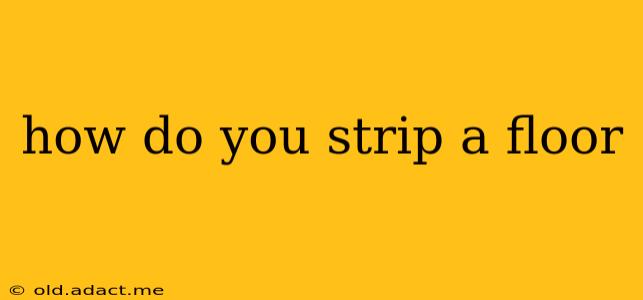Stripping a floor, whether it's hardwood, concrete, or another type of flooring, is a significant undertaking that requires careful planning and execution. This process involves removing old finishes like paint, varnish, wax, or adhesive to prepare the surface for refinishing or new flooring installation. This comprehensive guide will walk you through the essential steps, tools, and safety precautions to successfully strip your floor.
What Type of Floor Are You Stripping?
Before we delve into the specifics, it's crucial to identify the type of flooring you're working with. The method for stripping a floor varies greatly depending on the material:
- Hardwood floors: These require specialized techniques and equipment to avoid damaging the wood. We'll explore this in detail later.
- Concrete floors: These are typically stripped using chemical strippers or mechanical methods like grinding or shot blasting.
- Tile floors: Stripping tile floors usually involves removing the grout and tiles themselves, as opposed to stripping a finish.
- Vinyl or Linoleum floors: These are generally peeled up and discarded, rather than stripped.
This guide will primarily focus on stripping hardwood floors, as this is a common question and often requires more nuanced techniques.
What Tools and Materials Will You Need?
The tools and materials required will vary depending on the size and condition of your floor, and the type of finish being removed. However, here's a general list:
- Floor scraper: Essential for removing large amounts of finish.
- Putty knife: Useful for scraping stubborn areas and getting into corners.
- Sandpaper (various grits): For smoothing the surface after stripping. Start with a coarser grit and gradually move to finer grits.
- Chemical stripper: Choose a stripper appropriate for the type of finish on your floor. Always read and follow the manufacturer's instructions carefully.
- Safety glasses and respirator: Chemical strippers release fumes, so protection is paramount.
- Gloves: Protect your hands from the chemicals.
- Drop cloths: Protect your surrounding areas from spills and splashes.
- Steel wool pads: For finer scrubbing after the initial scraping.
- Vacuum cleaner: To remove dust and debris.
- Tack cloths: To remove any remaining dust particles before refinishing.
- Buckets and rags: For cleaning and applying the stripper.
How to Strip a Hardwood Floor: A Step-by-Step Guide
This process requires patience and methodical work:
- Preparation: Clear the area completely. Remove all furniture, rugs, and other items. Protect surrounding areas with drop cloths.
- Test the stripper: Apply a small amount of chemical stripper in an inconspicuous area to test its effectiveness and ensure it doesn't damage the wood.
- Apply the stripper: Follow the manufacturer's instructions for application. Typically, this involves spreading a generous layer of stripper evenly across a small section of the floor.
- Dwell time: Allow the stripper to dwell on the floor for the recommended time (usually specified on the product label). This allows the chemicals to break down the finish.
- Scrape the finish: Use a floor scraper to remove the softened finish. Work in small sections to avoid overloading the scraper. Be careful not to gouge the wood.
- Neutralize the stripper: Once all the finish is removed, neutralize the stripper according to the manufacturer's instructions. This often involves applying a neutralizing solution.
- Clean the floor: Thoroughly clean the floor with a damp mop to remove any remaining residue.
- Sanding: Once the floor is completely dry, sand the floor with progressively finer grits of sandpaper to smooth the surface.
- Final cleaning: Vacuum and use tack cloths to remove all dust particles.
How Long Does It Take to Strip a Floor?
The time required to strip a floor depends on several factors, including the size of the area, the type of finish, the number of coats, and your experience level. Expect the process to take several hours or even days for larger floors.
What Are the Safety Precautions When Stripping a Floor?
- Ventilation: Ensure adequate ventilation in the area to prevent buildup of harmful fumes. Consider opening windows and doors or using a fan.
- Protective Gear: Always wear safety glasses, a respirator, and gloves when working with chemical strippers.
- Disposal: Dispose of all chemicals and waste materials properly, according to local regulations.
Can You Rent Floor Stripping Equipment?
Yes, many rental stores offer floor stripping equipment, including floor sanders and buffers. This can significantly reduce the time and effort required for the project, especially for larger areas.
This comprehensive guide provides a solid foundation for stripping your floor. Remember to always prioritize safety and follow the manufacturer's instructions carefully for the best results. Remember to consult professional flooring contractors for larger or more complex projects.
